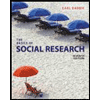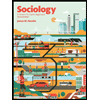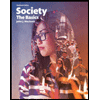
Concept introduction:
Consider how the introduction of technology causes upheaval in society and impacts daily lives of individuals.
Explanation of Solution
Suggested responses:
Ogburn theorized that technology was the primary force behind social change. He believed this happened in a process: First is the invention of the technology, second is the enhancement and application of the technology, and finally how we diffuse or spread the idea through many people and across cultures using it in our daily lives.
Ogburn said that although a society returns to equilibrium following a disruption such as the invention or diffusion of new technology, it does not do so all at once—there are some parts of society that reach the new balance at a different time than others. “Cultural lag” is the term used to describe the time it takes for society to “catch up” with the use of these technologies.
The concept of cultural lag is often applied to situations where there is a change in material culture (e.g., introduction of a new technology, such as the internet), but that change has not been met with change in nonmaterial culture (e.g., behavior, norms, guidelines regarding the use of technology).
Once the nonmaterial culture catches on and is forced to change as a result of the introduction of change in material culture, that is when significant social change occurs.
Ogburn’s theory can be applied to technologies used to communicate. Telecommunication technologies change rapidly, but often are not accompanied by rules or social norms. Long gone are the days when a person picked up a phone attached to the wall with a cord and shared one’s day with a friend. Some people even find phone calls to be rude, preferring text messages or emoji-filled messages sent via social media. Behaviors may vary by socioeconomic status, age, and education level. There are unclear rules about appropriate means or styles of communication, for example, in the workplace. Faux pas committed by employees or job candidates are a reflection of the cultural lag that accompanies new technologies.
On a personal level, many people have struggled with norms surrounding use of social media. Relationships have been strained and friendships ended because of divisive language or abusive behavior occuring on these technological platforms. Companies such as Facebook have also come under fire for the way personal data are collected, leading some users to abandon the platform altogether.
Want to see more full solutions like this?
Chapter 15 Solutions
Essentials of Sociology (12th Edition)
 Social Psychology (10th Edition)SociologyISBN:9780134641287Author:Elliot Aronson, Timothy D. Wilson, Robin M. Akert, Samuel R. SommersPublisher:Pearson College Div
Social Psychology (10th Edition)SociologyISBN:9780134641287Author:Elliot Aronson, Timothy D. Wilson, Robin M. Akert, Samuel R. SommersPublisher:Pearson College Div Introduction to Sociology (Eleventh Edition)SociologyISBN:9780393639407Author:Deborah Carr, Anthony Giddens, Mitchell Duneier, Richard P. AppelbaumPublisher:W. W. Norton & Company
Introduction to Sociology (Eleventh Edition)SociologyISBN:9780393639407Author:Deborah Carr, Anthony Giddens, Mitchell Duneier, Richard P. AppelbaumPublisher:W. W. Norton & Company The Basics of Social Research (MindTap Course Lis...SociologyISBN:9781305503076Author:Earl R. BabbiePublisher:Cengage Learning
The Basics of Social Research (MindTap Course Lis...SociologyISBN:9781305503076Author:Earl R. BabbiePublisher:Cengage Learning Criminalistics: An Introduction to Forensic Scien...SociologyISBN:9780134477596Author:Saferstein, RichardPublisher:PEARSON
Criminalistics: An Introduction to Forensic Scien...SociologyISBN:9780134477596Author:Saferstein, RichardPublisher:PEARSON Sociology: A Down-to-Earth Approach (13th Edition)SociologyISBN:9780134205571Author:James M. HenslinPublisher:PEARSON
Sociology: A Down-to-Earth Approach (13th Edition)SociologyISBN:9780134205571Author:James M. HenslinPublisher:PEARSON Society: The Basics (14th Edition)SociologyISBN:9780134206325Author:John J. MacionisPublisher:PEARSON
Society: The Basics (14th Edition)SociologyISBN:9780134206325Author:John J. MacionisPublisher:PEARSON





